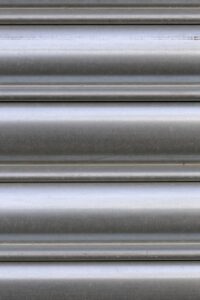 Selecting the correct material for the design of a spring is one of the first and most important considerations in its application. Stainless steel used for springs, for example, has many advantages and favorable properties—above all, corrosion resistance—which makes the material ideal for many applications. A variety of stainless steel grades and types are available for designers in applications, but there are other materials used in spring manufacturing, ranging from carbon spring steels to nickel-based spring alloys. Ultimately, the defining factor for material relates to the properties necessary for the spring to function as required, say, in a particular environment, temperature or load.
Selecting the correct material for the design of a spring is one of the first and most important considerations in its application. Stainless steel used for springs, for example, has many advantages and favorable properties—above all, corrosion resistance—which makes the material ideal for many applications. A variety of stainless steel grades and types are available for designers in applications, but there are other materials used in spring manufacturing, ranging from carbon spring steels to nickel-based spring alloys. Ultimately, the defining factor for material relates to the properties necessary for the spring to function as required, say, in a particular environment, temperature or load.
Copper and High-Carbon Spring Materials
Used for music wire and oil tempered spring wire, high-carbon spring steels are the most common spring material. In part because the material is inexpensive, but also because it is easily worked and readily available. However, the material has a limited operating temperature range and is not well-suited for shock or impact loading as alloy spring steels are. Alloy spring steel is made for high stress and impact loads and can operate in both higher and lower temperatures.
Though a more expensive spring material, copper-based spring alloys offer excellent electrical properties, good resistance to corrosion, and operate in sub-zero temperatures. Nickel-based spring alloys are also used in sub-zero temperature applications, as well as elevated temperatures. Combined with the material’s corrosion resistance and non-magnetic properties, nickel-based spring alloys are often designed for such applications as indicating instruments and gyroscopes.
Benefits of Stainless Steel for Springs
Yet, stainless steel holds many desirable properties that make it ideal for many spring applications. As an iron-based alloy, what sets stainless steel apart from other spring materials is its high corrosion resistance. Stainless steel consists of a minimum 10.5% chromium, which forms a tough, invisible, corrosion-resisting chromium oxide film that adheres to the steel surface, making it approximately 200 times more resistant to corrosion than steels without chromium. Other elemental alloys like nickel, magnesium, molybdenum, and nitrogen are often added to increase versatility.
In addition to its corrosion-resistant properties, stainless steel is well-known for its tensile strength, durability, biocompatibility, and low maintenance. It offers high and low-temperature resistance increased formability and easy fabrication. It is long-lasting, environmentally friendly, and recyclable. Once it is put into service, it does not need to be treated, coated or painted.
Stainless Steel Grades
Stainless steel is available in many different grades—300 or 400 series, for example—that are further subdivided into several metallurgical types—austenitic, ferritic, martensitic, and duplex. Determining the grade or type of stainless steel to use for spring design and fabrication will depend on the properties desired of the application. The most common grades of stainless steel spring wires are 302, 304, 316, and 17/7, all of which offer varying degrees of corrosion resistance, tensile strength and heat resistance.
Popular Applications
Medical Industry
Because of its versatility and many favorable properties as a material, stainless steel is ideally suited for applications in numerous industries. Stainless steel’s biocompatibility and hygienic characteristics provide the necessary properties for use as a spring material in medical applications. Stainless steel grades austenitic 304 and 316 are considered surgical or medical-grade stainless steel and are used as components in a variety of medical products, equipment, and pharmaceuticals.
Food Processing & Handling
Stainless steel’s easy cleaning makes it the first choice for applications requiring strict hygienic conditions. For similar reasons as the medical industry, stainless steel is commonly used in food-grade applications. Because grade 316 stainless steel springs resist moisture and rust, they are recommended for use as components where needed in food processing and handling equipment.
Power & Energy
The energy industry depends on stainless steel’s corrosion, chemical, and heat resistant properties. Stainless steel spring components are used in applications on oil and gas platforms, pipelines, and renewable energy sources like wind turbines. Emerging energy technologies like solar, hydro, and geothermal also utilize stainless steel spring components.
Transportation
The transportation sector is greatly impacted by stainless steel springs. The automotive, aerospace, rail, and marine industries all rely on stainless steel parts and components. Springs are, after all, the foundation of any vehicle’s suspension system, whether car, plane or on rail, but are also used for smaller parts such as hose clamps and seat belt springs. Rust and corrosion-resistant spring components are vital to marine applications. Marine-grade stainless steel springs are necessary where exposure to damages of saltwater, mist, fog is expected. The material’s standard passivation adds additional strength and resistance against the elements.
Durable Goods
Finally, stainless steel springs are also used as components in durable goods and appliances. From household kitchens and laundry rooms to commercial kitchens and dry cleaners, the many different appliances—dishwashers, refrigerators, freezers, ovens, microwave ovens, toasters, washing machines, dryers and so forth, consist of stainless steel spring components.
At James Spring & Wire, we strive to meet each one of our customers’ expectations by providing quality precision springs, on-time, and within budget. Check out our products for more information on all the types of springs we offer and as always, feel free to contact us with any questions or concerns.

